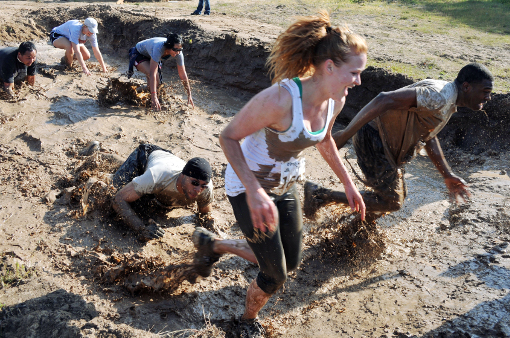Expert Q&A: How to Train for a Mud Run
Welcome to running’s latest craze: the mud run. For the uninitiated, a mud run is an obstacle course that varies in distance—generally between three to 12 miles—and includes, well, a whole lotta mud. The growing popularity of mud runs is proof that lots of children grow into adults and the impulse to get filthy never quiiiiite goes away. And since the point of a mud run isn’t to beat your neighbor but to simply complete the race, they’re usually a lot of fun, too.
I chatted with local trainer Ryan Tipping about how to train for the mud run, a race that will rear its grimy head in Philly in June (Tough Mudder and Dirty Girl 5K) and July (Merrell Down & Dirty). Tipping, a Philadelphia native, works at the Sporting Club at the Bellevue and has been a swim coach for seven years. He knows quite a bit about swimming in the mud, too.
What type of training do you recommend before completing a mud run?
What attracts most participants to mud runs is the unexpected. Athletes never know what kind of challenge waits at the next turn. What you can expect is that each course will include obstacles that will require an effort of pushing or pulling after running between a half-mile and two miles. Training-wise, I would recommend to beginning with a circuit that includes 400 meters of running, 10 pull-ups and 20 push-ups. Start out slow and see how many circuits you can do in 20 minutes.
In what ways is training for a mud run different than training for, say, a marathon?
In a way, the training is very similar. Anyone who has trained for a distance run knows the importance of working up to where you can do a run of 18-plus miles. When training for a mud run, the challenge is to simulate the race with training sessions that last as long as the race itself. A three-mile obstacle mud run takes many athletes 45 minutes to an hour to complete. It’s important to include not just running but also strength training in each workout. Mud runs, by the nature of what they are, test not only your running endurance but also your strength endurance.
Okay, so let’s talk running versus strength training. Is one more important than the other when it comes to training for a mud run?
You absolutely need to train for both, but one of the most common mistakes made by first-time mud runners is that they underestimate the amount of running involved; just because there are obstacles to focus on doesn’t mean the running distance is any less. That being said, both running and functional strength training are equally important. Functional strength training is a fancy term for strength, flexibility, speed and agility. I would focus on plyometrics (exercises that help build explosive power and speed, like box jumps, burpees and jumping lunges) paired with strength exercises (push-ups, pull-ups, planks and squats) with minimal breaks between exercises to build your cardiovascular endurance.
Besides the physical training, what kind of mental training should you do leading up to a mud run?
No matter how much you train, strength and speed will only take you so far in a mud run. These obstacle races also take a good amount of pure determination, since they will take most people out of their comfort zone and include moves you don’t typically incorporate into your gym routine. So heading into a mud run, you have to be mentally prepared to step outside of what you know and push through the challenges. Also, don’t underestimate the power of just having fun. Enjoying yourself while participating in a mud run will help you through some of the tougher obstacles even more than sheer determination.
In your experience, what is the one feature of the mud run that people find most intimidating?
The element of the unknown, especially if you’re a first timer. Most mud runs list the obstacles on their website so use that as a tool to guide your training. As long as you strength train while increasing your running distance, you shouldn’t have any problems. On race day, if you come across an obstacle you think you can’t do, ask for help, whether climbing a wall or a rope. The camaraderie of mud runners is amazing.
Do you have clothing suggestions for race day?
Wear something that is somewhat snug and fast drying and that you wouldn’t mind throwing away at the end. As far as sneakers go, wear what you trained in. Most races have a shoe donation pile at the end that will put those muddy kicks to good use instead of simply throwing them away.
Related Post
“If Running Sucks, You’re Doing It Wrong”: Q&A with Pro Runner Phil Clark



